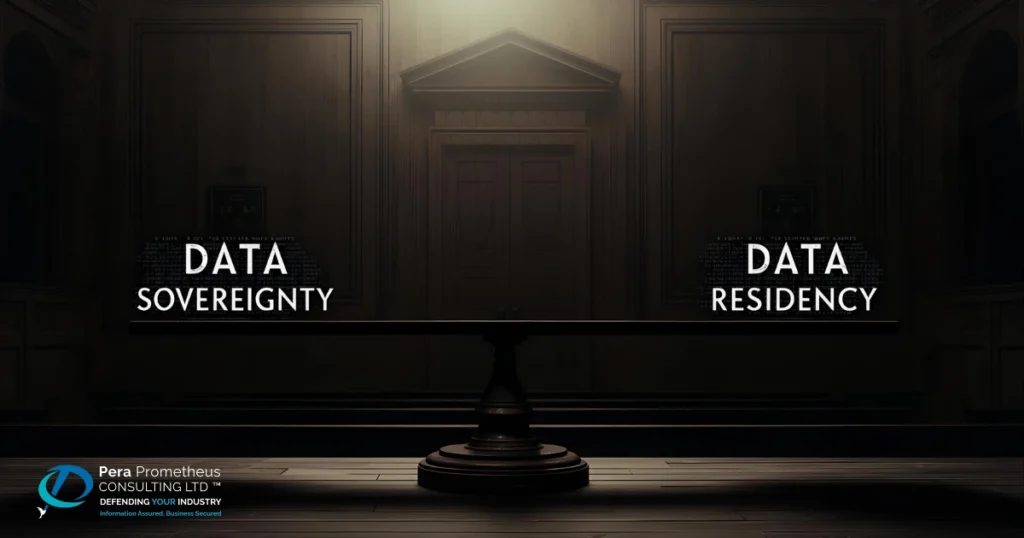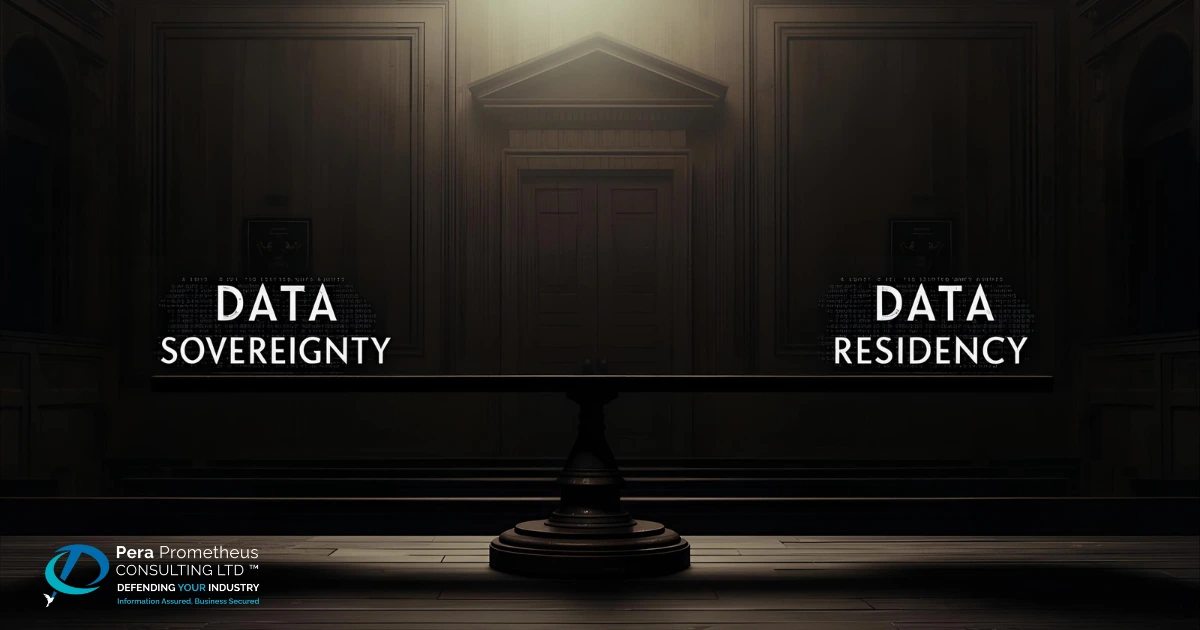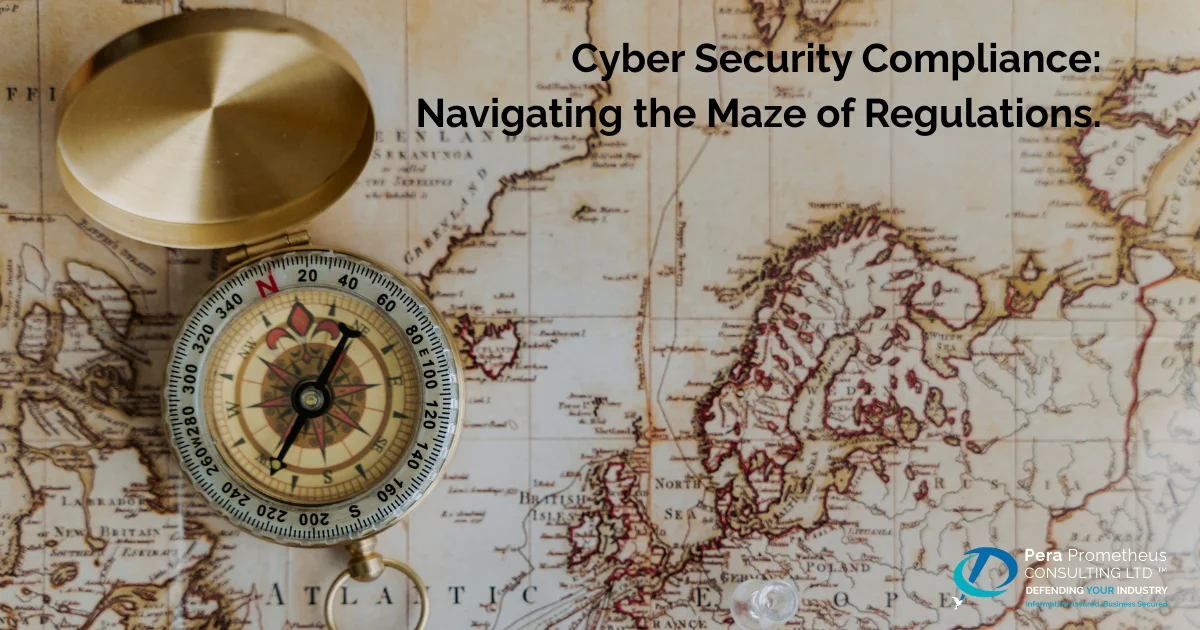– Gareth Shaw, MD Pera Prometheus
The current digital landscape is fuelled by data, therefore, concepts such as; data residency and data sovereignty have become increasingly important. With the rise of cloud computing, international data transfers, and stringent privacy regulations, organisations must navigate a complex web of rules to ensure compliance and protect sensitive information. But do you know the difference between data residency and data sovereignty? These terms are often used interchangeably, yet they represent distinct aspects of data management. Misunderstanding them can lead to legal pitfalls, financial penalties, and reputational damage.
In this blog, we’ll break down the definitions, highlight the key differences, explore why they matter, and provide practical insights for businesses.
Why Understanding These Concepts Matters
SMEs and supply chain operators increasingly rely on cloud services for storing and processing data, from customer records to sensitive defence-related information. A common scenario involves a UK-based SME in the defence supply chain uploading supplier details to a cloud platform, assuming secure storage in a geographically local data centre. However, audits may reveal unexpected international data flows, raising concerns under UK GDPR and associated contractual security requirements, potentially jeopardising contracts with larger defence partners. These implications extend beyond compliance.
Contract breaches can lead to substantial fines, reputational damage and expose client data to cyber threats. With cloud adoption on the rise among supply chains, clarifying terminology, data residency and data sovereignty being just one example, ensures organisations protect their operations while aligning with evolving regulations like the Data (Use and Access) Act 2025. This foundational knowledge empowers business leaders in SMEs and defence partnerships to make informed decisions in procurement and risk management, avoiding costly mistakes.
What is Data Residency?
Data residency refers to the physical or geographical location where data is stored and processed. It’s essentially about “where” the data lives. This concept ensures that data remains within specific borders or regions, often to comply with local laws or to optimise performance by reducing latency.
For instance, if a company operates in Europe and stores customer data in a data centre in France, that’s an example of data residency in action. The focus here is on the storage location, which can be influenced by factors like cost, infrastructure availability, and regulatory requirements. Data residency doesn’t inherently dictate the laws that apply; it’s more about the practical aspect of data placement.
According to experts, data residency is primarily concerned with the geographical location of the data itself, without necessarily addressing the governing laws. This makes it a foundational element for organisations using cloud services, where providers like AWS, Azure, or Google Cloud offer region-specific storage options.
What is Data Sovereignty?
Data sovereignty, on the other hand, goes beyond the location. It encompasses the legal and jurisdictional control over data, ensuring that it is subject to the laws of the country where it is stored or processed. In essence, it’s about “who” has authority over the data, typically the government of the host nation.
This concept asserts that data should be governed by the rules of the sovereign state in which it resides, including privacy protections, access rights, and enforcement mechanisms. For example, if data is stored in the UK, it must comply with UK data protection laws, regardless of the company’s origin. Data sovereignty protects against foreign government surveillance or unauthorised access, emphasising national control.
As defined in various sources, data sovereignty determines who has authority over data, focusing on jurisdictional control, including lawful access and enforcement power. It’s particularly relevant in scenarios involving cross-border data flows, where conflicts between international laws can arise.
Key Differences
Although data residency and sovereignty frequently intersect such as when UK-stored data falls under UK laws, they are distinct. Residency is location-based and static, whereas sovereignty is control-based and dynamic. IBM highlights that sovereignty is a legal concept tied to jurisdiction, while residency is purely geographical, with residency often influencing which sovereignty applies.
Here is a breakdown:
| Aspect | Data Residency | Data Sovereignty |
| Core focus | Physical or geographical location of data storage | Legal jurisdiction and regulatory control over data |
| Key concern | Where is the data stored? | Which laws apply to the data? |
| Scope | Geographical placement, often for performance or basic compliance | Legal framework, including access, privacy, and enforcement |
| Example risk | Data in a UK data centre but owned by a foreign firm, potentially exposing it to non-UK laws | UK data processed abroad temporarily, subjecting it to foreign courts despite UK storage |
These distinctions matter in practice. Consider a logistics SME in the defence supply chain using Microsoft Azure’s UK region for data residency, storing shipment records in London. However, because Azure is operated by a US-headquartered company, it falls under American legal jurisdiction. Under laws like the CLOUD Act (Clarifying Lawful Overseas Use of Data Act), US authorities may compel access to data—even if physically stored in the UK. Similar considerations apply to Amazon Web Services (AWS) and Google Cloud, whose global processing models may route data internationally for maintenance, analytics, or other operations.
Real-World Event
Recent events underscore these tensions. In a notable case reported by Computer Weekly, Microsoft declined to disclose international data flows for Police Scotland’s Office 365 deployment, hindering compliance with the Data Protection Act 2018’s restrictions on overseas policing data transfers. Microsoft’s refusal to provide information about its international data processing practices means the sensitive law enforcement data held by Police Scotland, including information about witnesses and victims of crime could be processed in “hostile” countries, or those without data adequacy agreements. This highlighted sovereignty risks, including potential routing to non-adequate jurisdictions like China.
Practical Guidance for Implementation
To address these issues organisations, especially SMEs who lack expert in-house support, should integrate residency and sovereignty considerations into core processes when planning Cloud based data deployments. For example, when evaluating Cloud or SaaS providers, request specifics on storage locations, data flow diagrams, and sovereignty assurances, including sub-processor lists in advance of agreeing contracts. The National Cyber Security Centre (NCSC) provides comprehensive Cloud security guidance, recommending thorough risk assessments for cross-border transfers. Similarly, the UK Government’s data protection resources outline GDPR obligations, emphasising lawful processing and transfer mechanisms. For defence applications, the Data Strategy for Defence outlines ambitions for data exploitation by 2025, prioritising sovereignty to treat data as a strategic asset.
Procurement policies must include clauses mandating UK residency and sovereignty audits. Boards can prompt Chief Information Security Officers (CISOs) or IT leads with targeted questions, such as: “How does our multi-cloud strategy uphold sovereignty in our supply chain?” or “What contingencies exist for unauthorised border crossings for data?” Early adoption of these measures fortifies resilience, aligning with government principles for data security that protect against unauthorised access or modification.
Frequently Asked Questions (FAQs)
To further clarify these concepts, here are answers to common queries on data residency and data sovereignty, geared towards SMEs and defence supply chains:
- What is data residency?
Data residency is the requirement that data be stored in a specific geographical location, such as within the UK, to meet regulatory standards like those in UK GDPR. It influences which laws apply based on storage sites. - What is data sovereignty?
Data sovereignty involves the legal control and jurisdiction over data, ensuring it adheres to the laws of the storing country and resists foreign regulatory interference. It empowers governments to regulate data handling comprehensively. - How to ensure compliance with data residency and sovereignty?
Conduct provider audits, embed clauses in contracts (where feasible), use data mapping tools, and reference NCSC guidelines for cloud security assessments. Consider sovereign cloud options for enhanced controls without heavy infrastructure costs. - What role does the Data (Use and Access) Act 2025 play?
The Act, effective from June 2025, streamlines certain data transfers while reinforcing protections, aiding sovereignty in public sector applications and promoting innovation under UK GDPR for supply chain efficiency.
Conclusion
Distinguishing data residency from data sovereignty is crucial for UK SMEs, defence partners, and supply chain businesses navigating cybersecurity compliance and cloud data regulations. Residency secures location, while sovereignty enforces control. Together, they safeguard against fines, breaches, and trust erosion in high-stakes operations.
Stay Safe, Stay Secure




